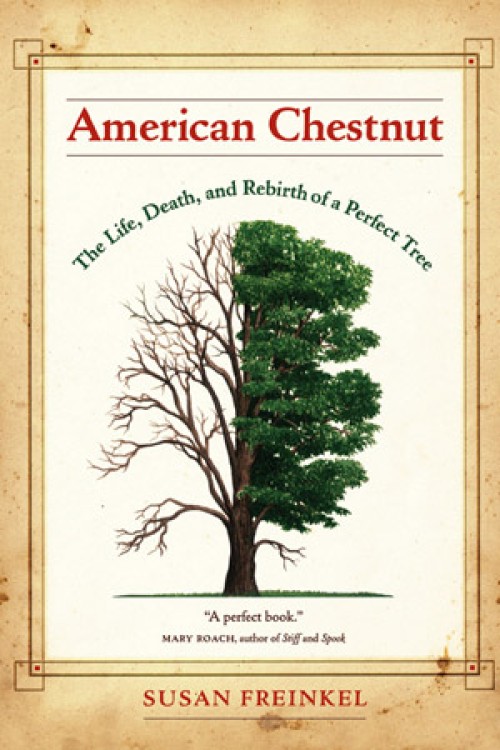by University of California Press, 2007
By Susan Freinkel
Somewhere in a marsh in northern Ohio stands an 85-foot-tall American chestnut tree. The existence of this tree, one of only a handful of its kind to survive chestnut blight, remained a secret until just this spring, and officials in Ohio’s Department of Natural Resources still won’t reveal its exact location.
The discovery of an American chestnut would not have made news at the turn of the twentieth century. These tall, leafy trees, members of the beech family, once dominated forests all along the eastern seaboard. But in 1904, a forester in New York City’s Zoological Park noticed that a previously healthy chestnut tree seemed to be dying. With the help of the U.S. Department of Agriculture, park staff soon concluded that the culprit was a fungus. At first, there didn’t appear to be great cause for concern. By the next spring, however, the fungus had spread to almost every chestnut tree in the park. Over the next few decades, the blight killed billions of trees from Maine to Georgia.
In American Chestnut, science writer Susan Freinkel recounts the discovery of chestnut blight and the ongoing attempts to save the species. Botany did not come naturally to Freinkel – “I’m not someone who hugs trees or talks to them,” she writes – but over the course of her research, she came to understand the importance of the chestnut to both the country’s landscape and its history.
Efforts to save the chestnut, she says, require “a marriage of science and passion.” So, Freinkel provides both a clear discussion of the science itself and compelling descriptions of the people doing the research, from the gruff forester who runs a breeding program on a farm in Connecticut to the enthusiastic scientists engaged in cutting-edge biotechnology work.
Some of the earliest attempts to tackle chestnut blight involved cross-breeding American trees with Japanese and Chinese chestnuts. Asian species of the tree had developed resistance to the blight over centuries of coexistence, so these efforts seemed promising, but the resulting trees rarely topped 50 or 60 feet, only half the height of some American chestnuts.
Similar efforts continue today, and other strategies have also emerged. In the mid-twentieth century, researchers found that European chestnuts seemed to resist the fungus better than American chestnuts, despite not having the natural immunity of Asian species. The explanation turned out to be a pathogen that attacks the fungus. Since that discovery, scientists have worked to use this fungal flu against the blight in the U.S.
More recently, some scientists have experimented with implanting genes that might offer resistance to the blight into chestnut DNA. Although the technology behind bioengineering seems likely to continue to improve, Freinkel worries that a transgenic tree would have unintended environmental consequences. She also fears that a successfully engineered chestnut tree would be used as propaganda by industry groups in support of their work to create trees with specific traits, such as low lignin content. “Intrigued as I am by the possibilities offered by biotechnology,” she writes, “I can’t help but wonder whether the real question is not if it can work, but whether I want it to.”
None of these or the other attempts Freinkel discusses has yet resulted in complete success. But regardless of whether an antidote is ultimately found, Freinkel thinks we can learn from the fate of what she calls a “perfect tree.” Perhaps, she says, “the chestnut can instruct us about the terrible fragility of even the mightiest species, including our own.”


